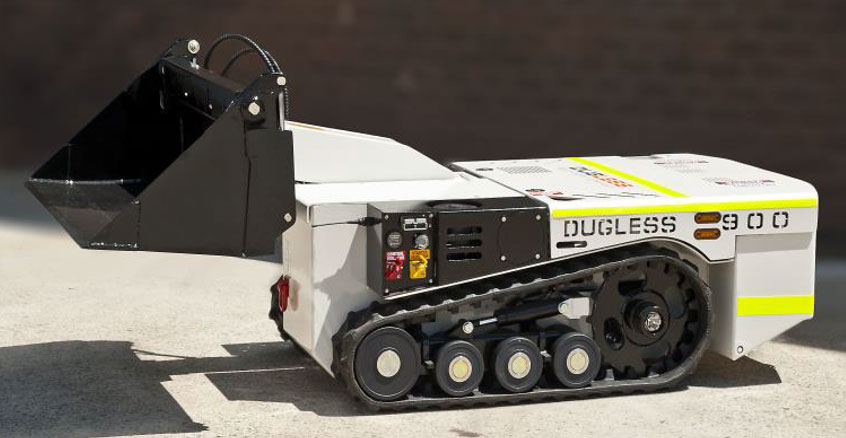DUGLESS – Innovation that stands the Test of Time
Minprovise builds a connection between productivity and safety with the Dugless 903 machine. General manager Tony Sutton explains the link to Australian Mining.
The mining industry doesn’t often encounter an innovation that was inspiring 10 years ago, yet is still relevant today.
Dugless 903, an automated digging and cleaning unit, generated industry hype as a machine 0.56 metres in height, allowing it to remove spillage and blockages from under low-lying conveyor sections in a way that larger machines previously could not.
Its remote-controlled system also removes the operator from the line of fire and allows plant conveyor systems to continue on with production while cleaning occurs, maximising site efficiencies.
Within a year of launching, the machine won the Best Practice in OH&S category at the Australian Bulk Handling Awards and was a finalist in the Innovative Mining Solutions category at the Australian Mining Prospect Awards.
Minprovise founder and managing director, Graham Townsend, developed the idea for Dugless 903 after observing remote-controlled, stand-on mini diggers, excavators and skid steers.
Townsend decided that stand-on style machines were too high for clean-ups underneath conveyor belts. He also viewed their short-wheel-base as a safety risk because workers were required to stand in a confined space, close to the machines tracks.
The experience led Townsend and his team at Minprovise to design a machine that is operated in a similar way, but is remotely controlled and capable of cleaning up spillages while a conveyor belt is still functioning.
This invention would importantly eliminate downtime. In fact, what five people could previously remove in one full day could now be achieved by the Dugless 903 in one hour.
There is still nothing quite like the Dugless 903 in the marketplace, according to Minprovise general manager Tony Sutton. Major mining companies have been, and are still the staunch adaptor of the technology, he says.
“One of the world’s biggest mining companies has ordered nearly 30 units. Considering the rigorous buying process a mining company has to go through, that success tells a story in itself,” Sutton tells Australian Mining.
In reality, it took over two years and more than $6 million in investment to arrive at a unit that the company was confident would produce the desired result.
“People underestimate the investment required to find an engine that can operate in such a low, compact area that is not water-cooled,” Sutton says.

“The Dugless is pretty much like a Volkswagen car, where the engine is air-cooled in a compact space to withstand harsh conditions.
“The way you design everything else around it needs to be taken into consideration. That’s not something that’s easy to achieve.”
The Dugless 903 did not only achieve what it was created to do. It went beyond its innovator’s vision when it was tasked to operate in wet conditions within an iron ore mine a few years ago.
Minprovise was asked to remove spillage underneath a series of belt filters with the Dugless. While water under the belts averaged 15 centimetres in depth, the Dugless never stopped, often operating with water over the axles.
Instead, it removed over 50 cubic metres of ore every day, an achievement that equates to approximately 7500 cubic metres of processed ore.
It would have been impossible to have people shovelling the spillage in the water all day, every day, for five months, according to Sutton.
The Dugless has, indeed, been designed to manoeuvre through different types of terrain, a capability that owes to its creator’s smart design thinking and choice of rubber tracks.
In an iron ore mine, two Dugless 903 machines have proven to remove 100 tonnes of ore from underneath a conveyor belt over a 200-metre stretch in 30 hours. The ore was then loaded onto a train and transported to port.
Elsewhere, two Dugless 903 units were operated over three 12-hour shifts to service a 400-metre section of a conveyor system. They successfully reclaimed an estimated 200 tonnes of iron ore.
The smart and safe machine has been enhanced by the development of technology over the past decade.
The advance of 3D printing allowed Minprovise to redesign the machine’s air intake system – from a standard filter arrangement, to a series of mini cyclones contained in one block.
“Technology continues to move forward, evident in the development of engines, computer systems and manufacturing techniques, such as the 3D printing,” Sutton says.
“The removal of dirt and dust with the mini cyclones removes over 85 per cent of dust particles, before it reaches the micro filters, which provides significantly better protection to the workings of the diesel engines.”
Minprovise has also applied smaller upgrades to Dugless. Its current operating system, remote control console, solenoid block configuration and the positioning of hydraulic hoses are the direct result of Minprovise’s work with its clients and commitment to improvements in quality control.
The Dugless 903 ultimately embodies its creator’s penchant for pushing boundaries, while keeping people and equipment in a safe zone.












